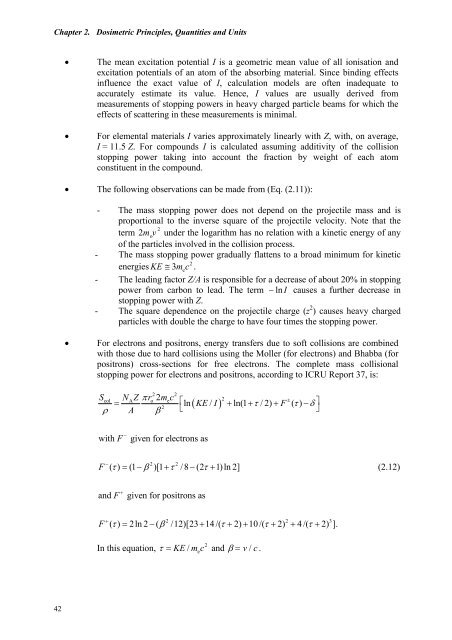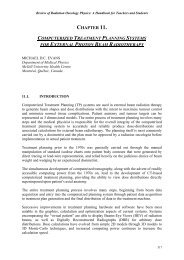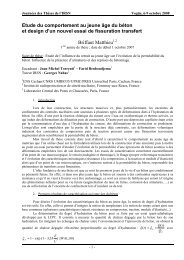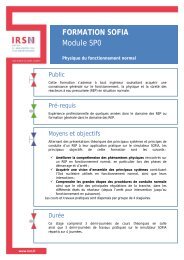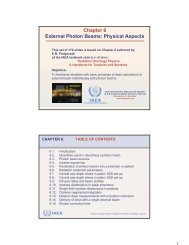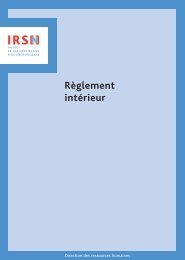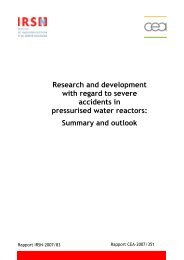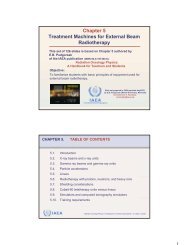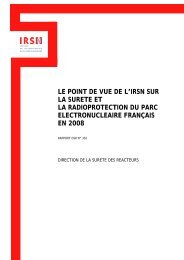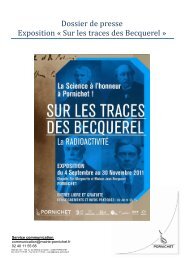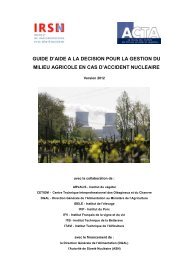chapter 2. dosimetric principles, quantities and units - IRSN
chapter 2. dosimetric principles, quantities and units - IRSN
chapter 2. dosimetric principles, quantities and units - IRSN
Create successful ePaper yourself
Turn your PDF publications into a flip-book with our unique Google optimized e-Paper software.
Chapter <strong>2.</strong> Dosimetric Principles, Quantities <strong>and</strong> Units• The mean excitation potential I is a geometric mean value of all ionisation <strong>and</strong>excitation potentials of an atom of the absorbing material. Since binding effectsinfluence the exact value of I, calculation models are often inadequate toaccurately estimate its value. Hence, I values are usually derived frommeasurements of stopping powers in heavy charged particle beams for which theeffects of scattering in these measurements is minimal.• For elemental materials I varies approximately linearly with Z, with, on average,I = 11.5 Z. For compounds I is calculated assuming additivity of the collisionstopping power taking into account the fraction by weight of each atomconstituent in the compound.• The following observations can be made from (Eq. (<strong>2.</strong>11)):- The mass stopping power does not depend on the projectile mass <strong>and</strong> isproportional to the inverse square of the projectile velocity. Note that theterm 2m ov 2under the logarithm has no relation with a kinetic energy of anyof the particles involved in the collision process.- The mass stopping power gradually flattens to a broad minimum for kinetic2energies KE ≅ 3mec.- The leading factor Z/A is responsible for a decrease of about 20% in stoppingpower from carbon to lead. The term − ln I causes a further decrease instopping power with Z.- The square dependence on the projectile charge (z 2 ) causes heavy chargedparticles with double the charge to have four times the stopping power.• For electrons <strong>and</strong> positrons, energy transfers due to soft collisions are combinedwith those due to hard collisions using the Moller (for electrons) <strong>and</strong> Bhabba (forpositrons) cross-sections for free electrons. The complete mass collisionalstopping power for electrons <strong>and</strong> positrons, according to ICRU Report 37, is:2 2Scol NAZπ ro 2mec2±= ⎡ln 2( KE / I ) + ln(1 + τ / 2) + F ( τ)−δ⎤ρ A β ⎣⎦with F−given for electrons asF= − + − +−2 2( τ) (1 β )[1 τ /8 (2τ1)ln2](<strong>2.</strong>12)<strong>and</strong> F+given for positrons asFτ = − β + τ + + τ + + τ + 3+2 2( ) 2ln 2 ( /12)[23 14 /( 2) 10 /( 2) 4 /( 2) ].2In this equation, τ = KE / m c <strong>and</strong> β = v / c .e42


